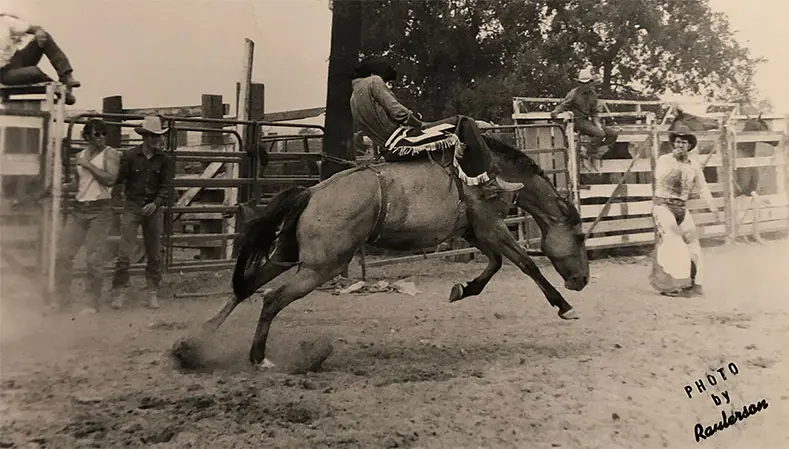
They ride horses and bulls, rope calves, buck broncs, fight bulls and even wrestle steers. They are cowboys. But because of the color of their skin, the legacies of their pursuits intersected with America’s struggle for racial equality, human rights and social justice.
Beginning at the dawn of the 20th century, their collective stories were set against the backdrop of reconstruction, Jim Crow, segregation, the civil rights movement and, eventually, the integration of a racially divided country. Their accomplishments and rightful place in history have largely gone unrecognized.
As PBR celebrates Black History Month, we will be publishing three photo galleries heralding Black cowboys of rodeo. Our first gallery showcases the pioneers who came from the East Coast.

Courtesy of Ferrell Butler
As a legendary rodeo photographer, Ferrell Butler was the first to photograph a rodeo with color film. In this photo from the Cheyenne Frontier Days rodeo in the mid-1960s, Butler captured New Jersey-raised cowboy Cowtown Gene Walker, who later went on to become a successful stuntman in Hollywood. Cowtown Gene, who attended Casper (Wyoming) College on a rodeo scholarship, and his brothers — Willie Ed and Jimmy Lee — were raised on the rodeo grounds in Pilesgrove, New Jersey, where their daddy worked as a ranch hand.

Courtesy of Bud Bramwell
Bud Bramwell was born and raised in Stamford, Connecticut. He learned to rope calves by the time he graduated high school and later was the first Black cowboy to earn a college rodeo scholarship when he transferred to Oklahoma State University to compete for the Cowboys. In 1968, he co-founded the American Black Cowboy Association along with Cleo Hearn, Marvel Rogers Sr. and Charles Evans with the help of former New Jersey congressman George Richardson. Bramwell was named president after winning a coinflip. The ABCA disbanded after the 1973 season, and Bramwell and the others refocused on their own respective rodeo careers.

Courtesy of Bud Bramwell
The seminal event produced by the American Black Cowboy Association was the first Black rodeo held September 5, 1971, in the cultural capital of Black America—Harlem. Here is a photo of Bramwell sitting in the stands at Downing Stadium alongside Sissy Nash, wife of singer Johnny Nash. Nash, who attended the rodeo and was as mesmerized by the accomplishments of Black rodeo cowboys as Muhammad Ali, who led a three-mile-long parade from the Apollo Theater to the rodeo event, is best remembered, a year later, for his lone No. 1 Billboard single “I Can See Clearly Now.”

Courtesy of Jesse “Charlie Reno” Hall
Jesse Hall was born July 24, 1943, in Vicksburg, Mississippi, and raised in New York City, where his mother had moved in the second Great Migration. He got his first taste of rodeo in 1963 and became professionally known as Charlie Reno—using his middle name and then taking the name of his first horse, Reno, as his own last name. By 1967, he established himself as bulldogger and bareback rider and fan favorite at the weekly Cowtown Rodeo. He signed his name to thousands of these black and white publicity photos in a career that lasted through the 1980 season.


Courtesy of Jesse “Charlie Reno” Hall
Dating back to 1929, the Cowtown Rodeo in Pilesgrove, New Jersey, is the oldest running weekly pro rodeo in the United States. It takes place every Saturday night — weather permitting — between Memorial Day Weekend and the end of September. In the 1970s and ’80s, the Harris family produced rodeos up and down the eastern seaboard under the Cowtown Rodeo banner, including New York City. In these two photos, Charlie Reno is competing in the steer wrestling event at Madison Square Garden.


Courtesy of Jesse “Charlie Reno” Hall
In 1980, Charlie Reno, who was well-known on the East Coast for some of the most spectacular buckoffs at the Cowtown Rodeo, one of which nearly cost him his life on June 1, 1968, capped off his career in 1980 by becoming the first African American to win the bareback and all-around titles in the American Rodeo Association.

Courtesy of Steve Robinson
Steve Robinson was born and raised in New Haven, Connecticut. He was 16 years old in 1972 when he called a local contractor to get an estimate on building a small horse barn in his family’s backyard. His father was not enthused, but Steve had spent all summer washing dishes and training horses up in Massachusetts and had $1,850 in the bank. He bought the supplies for a metal pole barn, and his parents—thanks to some convincing from his mother, who bought her two sons a saddle before they ever owned a horse—ordered a roof for the new barn from the annual Sears Suburban Farm & Ranch Catalog. After a successful rodeo career, and later as a rodeo producer and arena director, Robinson now trains horses at the Sunny Banks Ranch in Williston, Florida.

Courtesy of Bud Bramwell
Back in the 1960s, Bud Bramwell and the famous Walker brothers from New Jersey often competed together at rodeos on the East Coast. Eventually, Bramwell relocated to Stillwater, Oklahoma, and the oldest of the Walkers, Cowtown Gene, headed to Hollywood. In the years since, Cowtown Gene and Willie Ed Walker have passed away. Bramwell (left) and Jimmy Lee (right) now see each other once a year when they get together in Las Vegas for the National Finals Rodeo. Here they are on the Monday after the Finals saying goodbye in December 2019.
Keith Ryan Cartwright, a former editorial director and senior writer for PBR.com, is the author of the forthcoming book, “Black Cowboys of Rodeo: Unsung Heroes from Harlem to Hollywood and the American West.”